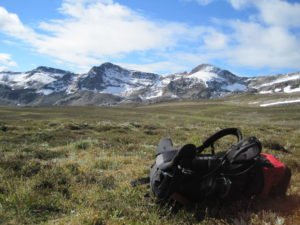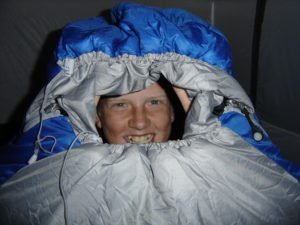Remember, you need to carry everything you pack, so less is more. Planning and efficient packing can greatly reduce bulk and weight. Remember that space tends to fill with extras if you aren’t careful. Multi-use and light-weight equipment can make a huge difference.
A well trained hiker can carry 1/3 of his body weight as “From the Skin Out” (FSO) weight, while a more comfortable range is 1/5-1/4 of body weight. Remember that you will also need to leave room for communal supplies/equipment such as food which will account for roughly an additional 15 pounds if you are backpacking.
We will try to get together before the actual trip to look over everyone’s equipment and make sure you aren’t missing something important. However, please carefully review our Day-Hiking Checklist (2454 downloads ) or Backpacking Checklist (2305 downloads ) while packing.
![]() If you have trouble viewing this document, try downloading the most recent version of Adobe Reader
If you have trouble viewing this document, try downloading the most recent version of Adobe Reader
Packs
Multi-day Backpack
- Internal Frame
- Min 65L
- Waist & Sternum straps
Backpacking involves carrying everything you need on, well, your back. It obviously follows that one of the most important pieces of equipment you will need is a comfortable, well-fitting hiking pack
Daypack
- Min 20L
This is a must for day-hikes and we may do side-trips from a base camp while backpacking, so you will need a smaller pack for some food, water and other essentials
Footwear
Hiking and backpacking involve lots of walking. A reasonable amount for an adult is 15km/day at 3.2 km/hr. Developing a consistent rhythm is vital to overall hiking performance, endurance and pleasure. We will take 10min breaks after each hour of walking and one longer break for lunch. It is generally accepted that each pound of footwear is as tiring as adding 5 pounds into your pack, so choosing light footwear is especially key.
 Hiking Boots
Hiking Boots
- Ankle support
- Water-proof
Blisters while hiking are basically a given. However, you can help minimize your blisters by making sure to “break in” your hiking boots. This involves consistently wearing them for a few weeks prior to the hiking trip.
Socks
- Shouldn’t modify the fit of your boots
- Not too tight or too loose
Another way to minimize blisters is to keep your feet dry and prevent hot spots. Wool and some synthetic fabrics (such as polypropylene or CoolMax) wick moisture away from feet far better than cotton. As well, many hikers wear two layers of socks to minimize friction and therefore hot spots…In fact, we recommend purchasing “double-layer” socks from a retailer such as MEC.
Sandals
- No heel strap
After a long day hiking or even during our lunch break, you will likely want to get out of your hiking boots. Packing light sandals will make these times much more enjoyable.
Sleeping Equipment
Sleeping Bag
- Minimum rating of -3C
Down (feather) filled sleeping bags are warmer and more compressible than synthetics of the same weight. However, down losses most of its insulating power when wet. Mummy bags are tapered at the bottom to minimize weight. A compression bag is a good idea to minimize the bulk of the sleeping bag.
Thermal pad
This raises you off a sometimes cold ground – the more collapsible the better.
Clothing (Quick-drying & breathable)
 Base layer (ie. Underwear)
Base layer (ie. Underwear)
The best base layer materials are synthetics (polypropylene and polyester). These are light and strong, absorb very little water, and are quick to dry. Silk is lovely and cool against the skin when it’s hot, but is not an excellent choice for colder conditions. Seamless or flat-seam garments lie flat and won’t press into your skin under a harness or pack. Base layers should fit snugly without being constricting and comfortable to avoid chafing. Consider long underwear – it can get rather cool in the mountains.
Mid-Layer
The mid-layer provides insulation and continues the transportation of moisture from the inner layer. To slow heat loss, this layer must be capable of retaining the warmth generated by your body. Wool and synthetics are well suited to this because the structure of the fibres creates small air spaces that trap molecules of warm air.
Additional features, such as pit zippers and full-length front zippers, allow venting. As with the inner layer, this layer should be snug but not constricting.
Outer Layer
The outer layer protects you from the elements and should allow air to circulate and excess moisture to escape. A shell made of a breathable and waterproof fabric, such as Gore-Tex, will protect you from wind and rain and allow water vapour to escape. If that isn’t in your budget, some sort of water-proof shell will work.
Other Supplies
Flashlight
Headlamps are useful for setting up tents and/or cooking in the dark
Water Bottle(s)
- Minimum 2.5L total capacity
Collapsible bottles weight less and take up very little room when empty. 1L of water weights 1kg (2.2 pounds)
At 3.2 km/hr, you will burn roughly 45 calories/100lb. Drink before you are thirsty…this can easily be as much as 5L/day.
Toiletries
Bears and other wildlife are attracted by scents, therefore only pack non-scented supplies. (ie. Arm & Hammer toothpaste, unscented sunscreen, no deodorant, etc.)
Blister Care
Everyone’s feet will react differently. Bring your own blister care products including mole skin and/or bandaids. Duct-tape works well to make sure your carefully attached covering doesn’t move.
Soap
Each hiker will be responsible for their own dishes and helping with the cooking clean up. We will be following the principles of Leave-No-Trace camping, so make sure the soap is biodegradable.
Tuque
An uncovered head accounts for 80% of body heat loss, so always pack a warm hat.


 Hiking Boots
Hiking Boots
 Base layer (ie. Underwear)
Base layer (ie. Underwear)